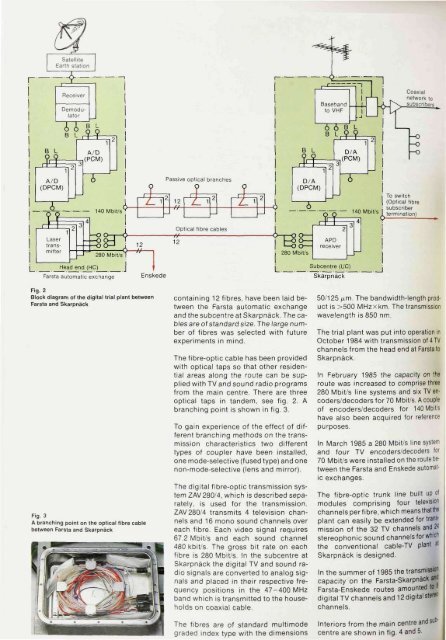Field Trial of Optical Fibre Cable-TV System Optical Fibre System for ...
Field Trial of Optical Fibre Cable-TV System Optical Fibre System for ...
Field Trial of Optical Fibre Cable-TV System Optical Fibre System for ...
Create successful ePaper yourself
Turn your PDF publications into a flip-book with our unique Google optimized e-Paper software.
Head end (HC]<br />
280 Mbit/s<br />
Farsta automatic exchange<br />
Enskede<br />
Subcentre (UC)<br />
Skarpnäck<br />
Fig. 2<br />
Block diagram <strong>of</strong> the digital trial plant between<br />
Farsta and Skarpnäck<br />
Fig. 3<br />
A branching point on the optical fibre cable<br />
between Farsta and Skarpnäck<br />
containing 12 fibres, have been laid between<br />
the Farsta automatic exchange<br />
and the subcentre at Skarpnäck. The cables<br />
are <strong>of</strong> standard size. The large number<br />
<strong>of</strong> fibres was selected with future<br />
experiments in mind.<br />
The fibre-optic cable has been provided<br />
with optical taps so that other residential<br />
areas along the route can be supplied<br />
with <strong>TV</strong> and sound radio programs<br />
from the main centre. There are three<br />
optical taps in tandem, see fig. 2. A<br />
branching point is shown in fig. 3.<br />
To gain experience <strong>of</strong> the effect <strong>of</strong> different<br />
branching methods on the transmission<br />
characteristics two different<br />
types <strong>of</strong> coupler have been installed,<br />
one mode-selective (fused type) and one<br />
non-mode-selective (lens and mirror).<br />
The digital fibre-optic transmission system<br />
ZAV280/4, which is described separately,<br />
is used <strong>for</strong> the transmission.<br />
ZAV280/4 transmits 4 television channels<br />
and 16 mono sound channels over<br />
each fibre. Each video signal requires<br />
67.2 Mbit/s and each sound channel<br />
480 kbit/s. The gross bit rate on each<br />
fibre is 280 Mbit/s. In the subcentre at<br />
Skarpnäck the digital <strong>TV</strong> and sound radio<br />
signals are converted to analog signals<br />
and placed in their respective frequency<br />
positions in the 47-400 MHz<br />
band which is transmitted to the households<br />
on coaxial cable.<br />
The fibres are <strong>of</strong> standard multimode<br />
graded index type with the dimensions<br />
50/125 /u.m. The bandwidth-length product<br />
is >500 MHzx km. The transmission<br />
wavelength is 850 nm.<br />
The trial plant was put into operation in<br />
October 1984 with transmission <strong>of</strong> 4 <strong>TV</strong><br />
channels from the head end at Farsta to<br />
Skarpnäck.<br />
In February 1985 the capacity on the<br />
route was increased to comprise three<br />
280 Mbit/s line systems and six <strong>TV</strong> encoders/decoders<br />
<strong>for</strong> 70 Mbit/s. A couple<br />
<strong>of</strong> encoders/decoders <strong>for</strong> 140 Mbit/s<br />
have also been acquired <strong>for</strong> reference<br />
purposes.<br />
In March 1985 a 280 Mbit/s line system<br />
and four <strong>TV</strong> encoders/decoders <strong>for</strong><br />
70 Mbit/s were installed on the route between<br />
the Farsta and Enskede automatic<br />
exchanges.<br />
The fibre-optic trunk line built up <strong>of</strong><br />
modules comprising four television<br />
channels perfibre, which means that the<br />
plant can easily be extended <strong>for</strong> transmission<br />
<strong>of</strong> the 32 <strong>TV</strong> channels and 2*<br />
stereophonic sound channels <strong>for</strong> which<br />
the conventional cable-<strong>TV</strong> plant at<br />
Skarpnäck is designed.<br />
In the summer <strong>of</strong> 1985 the transmission<br />
capacity on the Farsta-Skarpnäck anc<br />
Farsta-Enskede routes amounted to<br />
digital <strong>TV</strong> channels and 12 digital sterec<br />
channels.<br />
Interiors from the main centre and subcentre<br />
are shown in fig. 4 and 5.
















